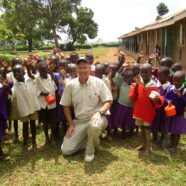
Procter & Gamble’s flagship social responsibility initiative has helped save the lives of 30,000 children globally. Katharine Earley explores how the firm is using the programme to engage consumers and meet its sustainability goals.
As the global water crisis intensifies, some 780m people lack access to safe water, while nearly 2,000 children under the age of five die from water and sanitation-related diarrheal diseases every day, more than from HIV/AIDS and malaria combined.
Increasingly, major companies are tackling fundamental health and development issues, including safe drinking water, as they move beyond cutting their own impacts to make a positive contribution to society. P&G is one such company. As a global manufacturer of everyday products, the $84bn consumer goods giant sees its responsibility very clearly as helping people to take small steps to improve their everyday lives. Committing time, funds and resource to addressing sustainable development issues also represents an investment in future markets.
Introducing Children’s Safe Drinking Water
Founded in 2004 by Dr Greg Allgood, the objective of the Children’s Safe Drinking Water programme is to reduce diarrheal disease and deaths among children caused by unsafe water. It forms a significant part of the company’s social responsibility strategy – social responsibility being one of the three pillars of P&G’s sustainability vision.
Developed in partnership with the US Centers for Disease Control and Prevention, the P&G packet or ‘P&G Purifier of Water’ is the first product to prominently carry the P&G name since 1904. Dissolving the contents of one sachet in ten litres of dirty water, stirring and pouring it through a cloth purifies the water in 30 minutes.
Partnering to maximise scale and reach
P&G has partnered with more than 120 not-for-profit organisations to distribute the packets in 70 countries. Partners include World Vision, Care, PSI and Save the Children. They are appointed for their local knowledge, on-the-ground expertise, and ability to reach people in remote locations.
“Maximising the impact of the programme means identifying and reaching the most vulnerable communities, including those living with HIV,” explains Children’s Safe Drinking Water programme manager Allison Tummon-Kamphuis. “We also work with partners to integrate the packets into wider health and education projects.”
P&G packets are sold at cost (3.5 cents) to the company’s partners, who sell them on via local distributors and engage in large scale social marketing in the target countries. Consumers pay between seven and ten cents per packet. The margin covers transport, import duty and education costs. In emergency relief situations (such as the 2004 tsunami in Indonesia or the 2010 floods in Pakistan), the packets are provided for free.
“People understand the value of the product, particularly if they’ve experienced a disease such as a cholera outbreak in their community,” says Tummon-Kamphuis.
With its sights set on delivering 200m packets per year by 2020, P&G opened a factory in Singapore in November 2012 to ramp up its production capacity.
Cultivating multiple sources of funding
The programme is financed by a mix of funding agencies, governments, partners and P&G itself, with a combined total of nearly $40m invested since its inception. To reach its 2020 goal, P&G must raise this investment to $20m/year, meaning new sources of funding are vital.
Increasingly, the company is eyeing consumer promotions as a potential funding stream. The brandSAVER coupon scheme in North America – a regular mailer sent to 75m households – has proved an effective way of engaging consumers with the safe water issue around key dates such as World Water Day.
Engaging UK shoppers
P&G’s current promotion with Asda supermarkets (Walmart’s UK supermarket chain) is its largest ever commercial promotion to raise funds for the programme. Running from 18th April to 8th May 2013, every P&G product bought in Asda’s 500+ stores will donate a day’s safe drinking water to the programme, with several products (including Gillette, Ariel, Fairy and Pantene) remaining linked to the programme throughout the year.
The move is intended to raise awareness of P&G’s sustainability credentials and offer consumers an easy, desirable way to help address a pressing sustainable development issue.
“We know from our research that consumers do want to make a difference, and this promotion represents a good opportunity for them to help,” explains Tummon-Kamphuis.
Exceeding social responsibility goals and enhancing reputation
P&G has distributed more than 540m P&G packets via the Children’s Safe Drinking Water programme since 2004, reaching more than 400m children with 5.4bn litres of safe water, averting an estimated 222 days of diarrheal illness and an estimated 29,000 deaths.
Results are tracked and evaluated via P&G’s own bespoke methodology, as well as feedback from NGO partners and a new WHO method for measuring improvements in household water.
In addition to exceeding its 2012 social responsibility goals and forging links with future markets, the main benefits to the company have been reputational. In particular, the programme has proved very inspiring to employees.
“There’s a definite interest from co-workers,” explains Tummon-Kamphuis. “And we regularly hear that it’s been a deciding factor in people wanting to work at P&G.”
Among its most recent awards, the programme has won the Patent for Humanity Award from the US Patent and Trade Office and the 2013 GBC Health ‘Community Investment’ Award.
Staying agile for the future
“We’ve learnt that what works in one country may not work in another, so a broad approach is essential,” says Tummon-Kamphuis. “The challenges we face are country specific and require local knowledge of governments and communities.”
Being nimble and flexible is also important – being ready to act quickly when the need arises. That’s why we work with our network of partners to prepare for emergencies ahead of time.”
P&G plans to deliver 2bn litres of safe water a year by 2020, saving a life every hour.
This article originally appeared on the 2degrees network site.

